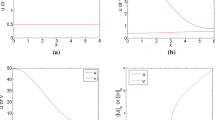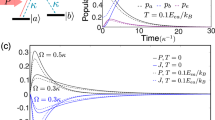Abstract
Since early 90’s, much attention has been paid to dynamic dissipative patterns in laboratories, especially, self-replicating pattern (SRP) is one of the most exotic phenomena. Employing model system such as the Gray-Scott model, it is confirmed also by numerics that SRP can be obtained via destabilization of standing or traveling spots. SRP is a typical example of transient dynamics, and hence it is not a priori clear that what kind of mathematical framework is appropriate to describe the dynamics. A framework in this direction is proposed by Nishiura-Ueyama [16], i.e., hierarchy structure of saddle-node points, which gives a basis for rigorous analysis. One of the interesting observation is that when there occurs self-replication, then only spots (or pulses) located at the boundary (or edge) are able to split. Internal ones do not duplicate at all. For 1D-case, this means that the number of newly born pulses increases like 2k afterk-th splitting, not 2n-splitting where all pulses split simultaneously. The main objective in this article is two-fold: One is to construct a local invariant manifold near the onset of self-replication, and derive the nonlinear ODE on it. The other is to study the manner of splitting by analysing the resulting ODE, and answer the question “2n-splitting or edge-splitting?” starting from a single pulse. It turns out that only the edge-splitting occurs, which seems a natural consequence from a physical point of view, because the pulses at edge are easier to access fresh chemical resources than internal ones.
Similar content being viewed by others
References
P.De Kepper, J.J. Perraud, B. Rudovics and E. Dulos, Experimental study of stationary Turing patterns and their interaction with traveling waves in a chemical system. Int. J. Bifurcation and Chaos,4, No. 5 (1994), 1215–1231.
E.J. Doedel, A.R. Champneys, T.F. Fairgrieve, Y.A. Kuznetsov, B. Sandstede and X. Wang, AUTO97: Continuation and bifurcation software for ordinary differential equations (with HomCont). ftp://ftp.cs.concordia.ca/pub/doedel/auto, 1997.
A. Doelman, T.J. Kaper and P.A. Zegeling, Pattern formation in the one-dimensional Gray-Scott model. Nonlinearity,10 (1997), 523–563.
A. Doelman, R.A. Gardner and T.J. Kaper, Stability analysis of singular patterns in the 1-D Gray-Scott model: A matched asymptotic approach. Physica D,122 (1998), 1–36.
A. Doelman, W. Eckhaus and T.J. Kaper, Slowly-modulated two pulse solutions in the Gray-Scott model I, II. SIAM J. Appl. Math, (in press).
S. Ei, The motion of weakly interacting pulses in reaction diffusion systems. To appear in J. D. D. E.
S. Ei, Y. Nishiura and B. Sandstede, Pulse interaction approach to self-replicating dynamics in reaction diffusion systems. Preprint, 2000.
H. Fujii, M. Mimura and Y. Nishiura, A picture of the global bifurcation diagram in ecological interacting and diffusing systems. Physica,5D (1982), 1–42.
P. Gray and S.K. Scott, Autocatalytic reactions in the isothermal, continuous stirred tank reactor: oscillations and instabilities in the systemA + 2B → 3B,B →C. Chem. Eng. Sci.,39 (1984), 1087–1097.
D. Henry, Geometric theory of semilinear parabolic equations. Lecture Notes in Mathematics840, Springer-Verlag, 1981.
Y. Kuznetsov, Elements of Applied Bifurcation Theory. Springer-Verlag, 1995.
K.J. Lee, W.D. McCormick, J.E. Pearson and H.L. Swinney, Experimental observation of self-replicating spots in a reaction-diffusion system. Nature,369 (1994), 215–218.
K.J. Lee and H.L. Swinney, Lamellar structures and self-replicating spots in a reactiondiffusion system. Phys. Rev. E,51 (1995), 1899–1915.
W. Mazin, K.E. Rasmussen, E. Mosekilde, P. Borckmans and G. Dewel, Pattern formation in the bistable Gray-Scott model. Mathematics and Computers in Simulation,40 (1996), 371–396.
C.B. Muratov and V.V. Osipov, Spike autosolitons in the Gray-Scott model. Preprint.
Y. Nishiura and D. Ueyama, A skeleton structure of self-replicating dynamics. Physica D,130 (1999), 73–104.
Y. Nishiura and D. Ueyama, Spatio-temporal chaos for the Gray-Scott model. Physica D (in press).
E. Ott, Chaos in Dynamical Systems. Cambridge Univ. Press, 1993.
J.E. Pearson, Complex patterns in a simple system. Science,216 (1993), 189–192.
V. Petrov, S.K. Scott and K. Showalter, Excitability, wave reflection, and wave splitting in a cubic autocatalysis reaction-diffusion system. Phil. Trans. Roy. Soc. Lond. A,347 (1994), 631–642.
K.E. Rasmussen, W. Mazin, E. Mosekilde, G. Dewel and P. Borckmans, Wave-splitting in the bistable Gray-Scott model. Int. J. Bifurcation and Chaos,6, No. 6 (1996), 1077–1092.
W.N. Reynolds, J.E. Pearson and S. Ponce-Dawson, Dynamics of self-replicating patterns in reaction diffusion systems. Phys. Rev. Lett.,72, No. 17 (1994), 1120–1123.
W.N. Reynolds, S. Ponce-Dawson and J.E. Pearson, Self-replicating spots in reactiondiffusion systems. Phys. Rev. E,56, No. 1 (1997), 185–198.
D. Ueyama, Dynamics of self-replicating dynamics in the one-dimensional Gray-Scott model. PhD thesis.
J. Wei, On two dimensional Gray-Scott model: existence of single pulse solutions and their stability. Preprint, 1999.
Author information
Authors and Affiliations
Additional information
This research was supported in part by Grant-in-Aid for Scientific Research 09440071 and 09874039, Ministry of Education, Science and Culture, Japan.
About this article
Cite this article
Ei, Si., Nishiura, Y. & Ueda, Ki. 2n-splitting or edge-splitting? — A manner of splitting in dissipative systems —. Japan J. Indust. Appl. Math. 18, 181–205 (2001). https://doi.org/10.1007/BF03168570
Received:
Revised:
Issue Date:
DOI: https://doi.org/10.1007/BF03168570




